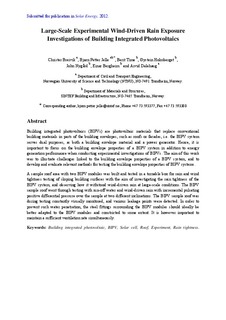| dc.contributor.author | Breivik, Christer | |
| dc.contributor.author | Jelle, Bjørn Petter | |
| dc.contributor.author | Time, Berit | |
| dc.contributor.author | Holmberget, Øystein | |
| dc.contributor.author | Nygård, John Simen Seeberg | |
| dc.contributor.author | Bergheim, Einar | |
| dc.contributor.author | Dalehaug, Arvid | |
| dc.date.accessioned | 2017-03-30T07:56:45Z | |
| dc.date.available | 2017-03-30T07:56:45Z | |
| dc.date.created | 2013-01-04T01:51:51Z | |
| dc.date.issued | 2013 | |
| dc.identifier.citation | Solar Energy. 2013, 90 (April), 179-187. | nb_NO |
| dc.identifier.issn | 0038-092X | |
| dc.identifier.uri | http://hdl.handle.net/11250/2436291 | |
| dc.description.abstract | Building integrated photovoltaics (BIPVs) are photovoltaic materials that replace conventional building materials in parts of the building envelopes, such as roofs or facades, i.e. the BIPV system serves dual purposes, as both a building envelope material and a power generator. Hence, it is important to focus on the building envelope properties of a BIPV system in addition to energy generation performance when conducting experimental investigations of BIPVs. The aim of this work was to illustrate challenges linked to the building envelope properties of a BIPV system, and to develop and evaluate relevant methods for testing the building envelope properties of BIPV systems.
A sample roof area with two BIPV modules was built and tested in a turnable box for rain and wind tightness testing of sloping building surfaces with the aim of investigating the rain tightness of the BIPV system, and observing how it withstood wind-driven rain at large-scale conditions. The BIPV sample roof went through testing with run-off water and wind-driven rain with incremental pulsating positive differential pressure over the sample at two different inclinations. The BIPV sample roof was during testing constantly visually monitored, and various leakage points were detected. In order to prevent such water penetration, the steel fittings surrounding the BIPV modules should ideally be better adapted to the BIPV modules and constricted to some extent. It is however important to maintain a sufficient ventilation rate simultaneously. | nb_NO |
| dc.language.iso | eng | nb_NO |
| dc.publisher | Elsevier | nb_NO |
| dc.rights | Attribution-NonCommercial-NoDerivatives 4.0 Internasjonal | * |
| dc.rights.uri | http://creativecommons.org/licenses/by-nc-nd/4.0/deed.no | * |
| dc.title | Large-Scale Experimental Wind-Driven Rain Exposure Investigations of Building Integrated Photovoltaics | nb_NO |
| dc.type | Journal article | nb_NO |
| dc.type | Peer reviewed | nb_NO |
| dc.source.pagenumber | 179-187 | nb_NO |
| dc.source.volume | 90 | nb_NO |
| dc.source.journal | Solar Energy | nb_NO |
| dc.source.issue | April | nb_NO |
| dc.identifier.doi | 10.1016/j.solener.2013.01.003 | |
| dc.identifier.cristin | 980541 | |
| dc.relation.project | Norges forskningsråd: 193830 | nb_NO |
| dc.description.localcode | Copyright © 2013 Elsevier Ltd. All rights reserved. This is the authors' accepted and refereed manuscript to the article. | nb_NO |
| cristin.unitcode | 194,64,35,0 | |
| cristin.unitname | Institutt for bygg, anlegg og transport | |
| cristin.ispublished | true | |
| cristin.fulltext | original | |
| cristin.fulltext | postprint | |
| cristin.qualitycode | 2 | |

